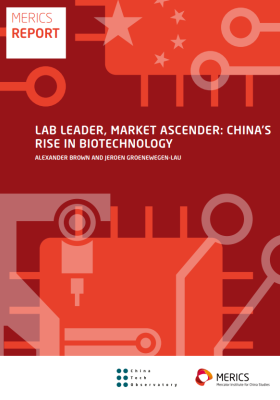

R&D support + Financing innovative SMEs + Government procurement
1. MIIT strengthens support for R&D in core industrial technologies
At a glance: The Ministry of Industry and Information Technology (MIIT) announced new research funding rounds, paid for by the central government through the National Key Research & Development Projects (NKP) program. The notice covers 16 categories such as smart sensors, industrial software and rare earth new materials, and has attachments detailing dozens of additional research tasks for each category. Scientific research institutes, universities and enterprises are encouraged to apply to contribute to specific research and development (R&D) tasks and are expected to contribute a share of the costs. The policy highlights four project management measures:
- Create more opportunities for young researchers to organize and implement major R&D tasks through the Young Scientist Program
- Coordinate the investment and management of officials at the ministerial, provincial, and city level to advance high priority projects
- Leverage the “unveil the list” research model, combining R&D funding and government procurement, to strengthen the commercialization of outputs and to clarify end users
- Develop technology readiness frameworks to enhance the output of results
MERICS comment: The NKP program is China’s main state funded research program for the applied sciences. It serves a key role in advancing the government’s industrial goals, as shown by the project categories’ strong concentration on technologies linked to advanced manufacturing. Of the 16 areas, 15 relate to industrial materials, inputs or equipment. Electric vehicles (EVs) are the only consumer product listed.
The management measures reflect the eagerness of China’s leaders to turn investments in R&D into tangible commercial results. The rise of China’s EV industry is a prominent successful example, as it has been facilitated by NKP funding since 2016. Medical robotics is another sector where years of investment in NKP projects has supported the growth of home-grown firms. Policymakers in Beijing hope to replicate this success, particularly in core technologies that can be applied across different sectors.
If successful, these R&D projects will advance China’s industrial competitiveness and its ambitions to localize core technologies. Foreign firms should pay attention to which specific technologies are being developed, especially if they match their own core business, and should monitor the progress of the actors involved.
Article: Notice on the National Key R&D Program 2024 Annual Project Application Guidelines for “High-performance Manufacturing Technology and Major Equipment” and 16 other Key Special Projects (工业和信息化部关于发布国家重点研发计划“高性能制造技术与重大装备”等16个重点专项2024年度项目申报指南的通知) (Link)
Issuing body: MIIT
Date: August 9, 2024
2. Beijing steps up financing for innovative SMEs
At a glance: The Ministry of Finance (MOF) and three other agencies issued measures to improve access to financing for innovative small and medium-sized enterprises (SMEs). They focus on the national financing guarantee fund, which is intended to encourage banks to grant more loans to SMEs, by providing surety for a share of the loan amount. Key goals of the notice include:
- Raise the risk-sharing ratio of the national financing guarantee fund from 20 percent to a maximum of 40 percent
- Adjust the guarantee fund’s maximum risk-sharing ratio by type of company, varying from 40 percent for Little Giant companies to 30 percent for science and technology based and innovative SMEs
- Increase the upper limit of the insured amount for a single SME in the science and technology innovation category from CNY 10 million to CNY 30 million
MERICS comment: The Chinese government has grappled with the problem of SME’s lack of access to financing for years. Banks have proved reluctant to hand out loans to SMEs as smaller firms often lack collateral. They prefer to lend to state-owned enterprises (SOEs). It remains to be seen if the new special guarantee plan will prove sufficient to convince banks to lend more to SMEs. The changes to the risk-sharing ratio lift the ceiling on how much of the loan the financing guarantee fund can vouch for, but nothing obliges the fund to do so. The scope of the fund may also be insufficient. Since its establishment in 2018, the guarantee fund has served SMEs with a total of 40 million employees, which is a small share of total SME employment.
However, the measures specifically target high-tech SMEs in strategic sectors. The Little Giants and innovative SMEs being prioritized here tend to operate in the same sectors traditionally dominated by European SMEs, such as in machinery and vehicles. Improved funding for these Chinese firms poses competitive risks to European firms in terms of market share, both inside China and abroad.
Article: Notice on the Implementation of a Special Guarantee Plan to Support Scientific and Technological Innovation (关于实施支持科技创新专项担保计划的通知) (Link)
Issuing bodies: MOF, MOST, MIIT, NFRA
Date: July 26, 2024
3. State Council once again promises fair access to government procurement
At a glance: The State Council issued a three-year action plan (2024-2026) for government procurement to address prevalent issues such as unfair practices, regulatory gaps, and inefficiencies within the procurement process. Key goals by 2026 include:
- Enhance the business environment through coordinated enforcement actions to rectify illegal procurement practices, including discriminatory terms set by purchasers, the charging of excessive fees and supplier fraud
- Improve government procurement laws and regulations by benchmarking them against international rules such as the WTO’s Government Procurement Agreement (GPA) and the Comprehensive and Progressive Trans-Pacific Partnership Agreement (CPTPP)
- Support the development of SMEs through procurement, including by reserving a share of engineering projects valued at more than CNY 4 million for SMEs
- Expand green procurement initiatives by enforcing policies that prioritize environmentally friendly products and materials in government projects
MERICS comment: European companies have long complained that China’s regulatory framework for government procurement puts them at a disadvantage. They are denied significant business opportunities in sectors such as medical devices, civil engineering, and telecommunications. China’s government has made repeated promises – including in the Foreign Investment Law – to grant foreign firms equal access, yet challenges continue. Despite a commitment to join the Government Procurement Agreement “as soon as possible” after China’s 2001 accession to the WTO, Beijing has submitted seven offers but still not concluded negotiations. As such, this new action plan should be taken with a grain of salt.
Yet, there are reasons for cautious optimism. It is possible that Beijing intends to make incremental changes to the procurement system, even if not substantial reforms. Numerous policies released this year, such as on the administration of national bidding and tendering practices, suggest the government will handle discriminatory procurement practices more strictly. Even a small improvement could bring significant benefits for foreign firms. China’s incentives to align with international standards are growing, given the increased interests of its own firms in foreign markets, including Europe.
Article: Three-Year Action Program on “Rectifying Market Order, Building a Regulatory System and Promoting Industrial Development” in the Field of Government Procurement (2024-2026) (政府采购领域“整顿市场秩序、建设法规体系、促进产业发展”三年行动方案(2024—2026年)) (Link)
Issuing body: State Council
Date: July 4, 2024
4. Greening is back on the agenda: China to establish control system for emissions
At a glance: The State Council released a plan to switch from using energy consumption as a key indicator for measuring decarbonization to tracking carbon emissions directly. The new dual control system will review emissions intensity and total emissions. China’s leadership regards the system as an important step toward peaking China’s carbon emissions by 2030. Key targets outlined in the plan include:
- Improve the carbon emission statistical accounting system, establish a national greenhouse gas emissions factor database, issue carbon emissions accounting standards and product carbon footprint standards by 2025
- Implement the carbon emissions dual control system across the country with a focus on the carbon intensity component during the "15th Five-Year Plan" period (2026-2030)
- Shift the focus to total carbon emissions after the carbon peak
MERICS comment: The existing approach of measuring the intensity and total amount of energy consumption has several drawbacks, which the new proposals seek to fix. The current system fails to distinguish whether electricity is generated using fossil fuels or renewable energy, a shortcoming that hinders the expansion of green energy use and generation. It has also stymied the growth of the energy-intensive raw materials sector, regardless of the sector’s efforts to lower emissions.
The new dual control system reflects Beijing’s renewed resolve to push forward its decarbonization agenda. Recently, the CCP has prioritized energy security over the green transformation, after severe energy shortages caused economic shocks in 2021. The government stockpiled coal, improved grid management and boosted interprovincial power sharing, among other measures. The reprioritization of greening is evident from the many green regulations issued in recent months, ranging from high-level guidance on the green transition to the action plan for low carbon data centers.
China’s energy transition could offer business opportunities for European companies. Foreign investment is being encouraged in sectors such as new energy power stations, biogas projects, the hydrogen industry, carbon capture, utilization, and sequestration, and recycling. European firms may also welcome China’s renewed efforts since they already have decarbonization plans in place. Subjecting Chinese companies to stricter standards could go some way to leveling the playing field.
Article: Notice on the Work Plan for Accelerating the Construction of a Dual Carbon Emission Control System (国务院办公厅关于印发《加快构建碳排放双控制度体系工作方案》的通知) (Link)
Issuing body: State Council
Date: August 2, 2024
5. In with the new: Subsidies to boost demand for new energy city buses
At a glance: The Ministry of Transport and Ministry of Finance (MOF) released instructions for a new subsidy program aimed at replacing old new energy urban buses and renewing outdated batteries. Key measures include:
- An average subsidy of CNY 80,000 per vehicle for replacements of new energy city buses registered before December 31, 2016
- Offer CNY 42,000 per bus to replace outdated power batteries in existing new energy buses
- Implement regional financial support, with central government covering 85 percent of the subsidy funds in the eastern provinces and 95 percent in the western provinces; local governments are to cover the remainder
MERICS comment: The new subsidy guidelines reflect China's ongoing push to lead the global transition to sustainable transportation. The policy aims to boost demand by covering 5-10 percent of the cost of a new NEV bus. China is already a global leader in electric bus manufacturing, with 70 percent of electric bus sales worldwide in 2023. However, the domestic market for electric buses has cooled in recent years. Sales have fallen by about two thirds between 2021 and 2023. In 2022, the ending of purchase subsidies for battery-electric and plug-in hybrid buses, and the maturing domestic market, led to a shift toward exports. It remains to be seen if the new subsidies will spur local governments to upgrade their bus fleets, especially given the rising constraints on local government budgets.
For European firms, the guidelines may reinforce the challenges they already face in the Chinese market. They have been largely squeezed out by dominant local players or remain dependent on local JV partners. With companies like Yutong and BYD expanding their influence globally, European manufacturers might also see further competitive pressures in their home markets and in third country markets. Every year since 2020, Chinese firms have secured about 30 percent of electric bus sales in EU-27 countries. If they get a boost to sales in China, they could be enabled to cut prices and expand their market share abroad.
Article: Implementation Rules for the Renewal Subsidy for New Energy City Buses and Power Batteries (新能源城市公交车及动力电池更新补贴实施细则交通运输部财政部关于印发《新能源城市公交车及动力电池更新补贴实施细则》的通知) (Link)
Issuing bodies: MOT, MOF
Date: July 31, 2024
Noteworthy
Policy news
- July 1: The MIIT released the 2024 manufacturing talent support plan under which selected entrepreneurs and other talented individuals receive special training and their companies get priority in undertaking projects in industry and information technology (MIIT notice)
- July 12: The MIIT, together with eight other government agencies, released an innovation and development plan for the fine chemicals industry, aiming to cultivate five world-class enterprises and 500 “Little Giant” companies in the sector by 2027 (MIIT notice)
- July 21: In its Third Plenum resolution, the 20th Central Committee of the Chinese Communist Party (CCPCC) doubled down on high-quality economic growth driven by “new-quality productive forces” as well as technological self-reliance, while also promising better treatment for private companies, for example by reducing market restrictions (CCPCC resolution)
- July 23: The National Development and Reform Commission (NDRC) and two other agencies published an action plan for the development of low-carbon data centers, setting the sector a goal of reaching internationally advanced levels of power utilization efficiency, unit computing power efficiency and carbon efficiency by 2030 (NDRC notice)
- July 25: The NDRC and MOF pledged CNY 300 billion of ultra-long-term special treasury bonds to support large-scale equipment upgrades and the replacement of old consumer goods with new ones (NDRC notice)
- August 5: The MIIT released an application call for “unveiling the list” for chemical fiber and oil enterprises, a mechanism intended to support the joint research by chemical fiber and oil companies and to strengthen their supply chain relationships (MIIT notice)
- August 8: The MIIT provided details on the application process to join the list of industrial machine tool enterprises that will benefit from the value-added tax additional deduction policy in 2024 (MIIT notice)
- August 19: China approved 11 nuclear reactors across five sites with a combined value of EUR 27.8 billion (CNY 220 billion), further boosting its decarbonization drive (The Paper article)
- August 21: The CCPCC and State Council released opinions on improving the market access system, for instance for new formats and new fields such as deep sea, aerospace, aviation, new energy and artificial intelligence (CCPCC notice)
Corporate news
- July 8: German optical systems giant ZEISS opened its new R&D and manufacturing site in Suzhou, China, after investing CNY 250 million in its construction (ZEISS announcement, Caixin article)
- July 9: Huawei reports that it has completed construction of its largest ever R&D center in Qingpu, Shanghai; the CNY 10 billion center will have about 30,000 personnel and focus on breakthroughs in semiconductors, wireless networks, and the Internet of Things (Sohu article, Bloomberg article)
- July 12: The MIIT added Xiaomi to its list of “all-electric passenger car manufacturers,” meaning the electronic consumer goods leader now has the go ahead to produce its own electric vehicles (MIIT notice, Technode article)
- July 20: China State Shipbuilding Group's 704 Research Institute successfully developed a 10-megawatt podded marine propulsion system (SASTIND article)
- July 23: The Civil Aviation Administration of China (CAAC) granted approval to two units of EHang Holdings Ltd to operate pilotless electric vertical takeoff and landing (eVTOL) aircraft (Caixin article)
- July 26: China's leading battery manufacturer CATL received 35 percent more in state subsidies during the first half of 2024 than in H1 2023; CATL was the top recipient of government subsidies in 2023 among all companies listed in mainland China (Nikkei Asia article)
- August 9: Zhao Haijun, Co-CEO of China’s top chipmaker Semiconductor Manufacturing International Corp. (SMIC), announced the company is accelerating its capacity buildout due to geopolitics-induced changes in the supply chain; SMIC wants to reach additional monthly capacity of 60,000 300-millimeter wafers by December, ramping up from an extra 30,000 to 50,000 wafers as previously planned (Bloomberg article)
- August 19: Shanghai’s first humanoid robot factory, built by local startup Agibot, is nearing completion and scheduled to ship 200 bipedal and 100 wheeled robots by the end of this year (Yicai article, East Money article)

